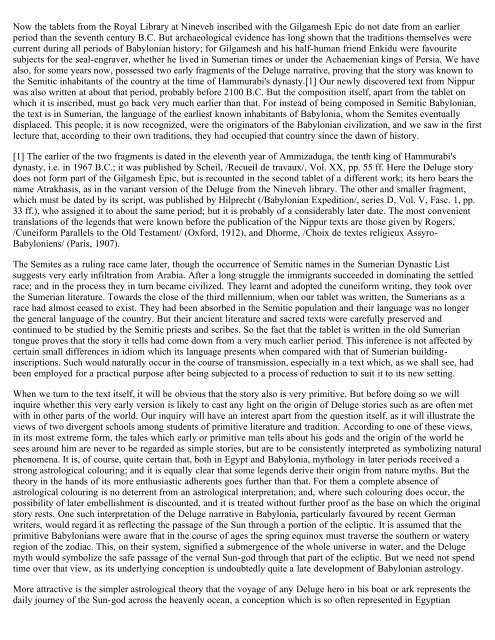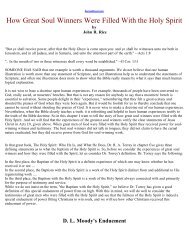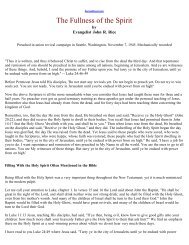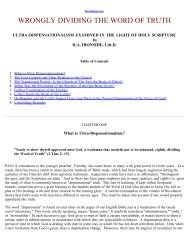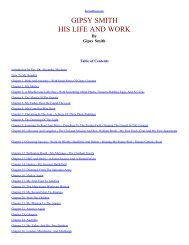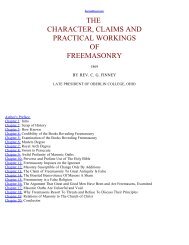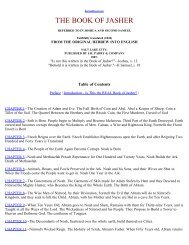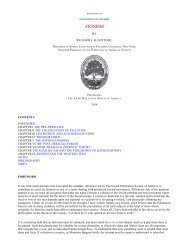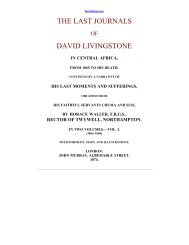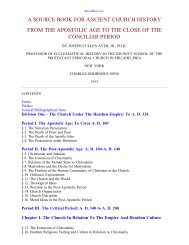Legends of Babylon and Egypt in Relation to Hebrew Tradition.pdf
Legends of Babylon and Egypt in Relation to Hebrew Tradition.pdf
Legends of Babylon and Egypt in Relation to Hebrew Tradition.pdf
You also want an ePaper? Increase the reach of your titles
YUMPU automatically turns print PDFs into web optimized ePapers that Google loves.
Now the tablets from the Royal Library at N<strong>in</strong>eveh <strong>in</strong>scribed with the Gilgamesh Epic do not date from an earlier<br />
period than the seventh century B.C. But archaeological evidence has long shown that the traditions themselves were<br />
current dur<strong>in</strong>g all periods <strong>of</strong> <strong>Babylon</strong>ian his<strong>to</strong>ry; for Gilgamesh <strong>and</strong> his half-human friend Enkidu were favourite<br />
subjects for the seal-engraver, whether he lived <strong>in</strong> Sumerian times or under the Achaemenian k<strong>in</strong>gs <strong>of</strong> Persia. We have<br />
also, for some years now, possessed two early fragments <strong>of</strong> the Deluge narrative, prov<strong>in</strong>g that the s<strong>to</strong>ry was known <strong>to</strong><br />
the Semitic <strong>in</strong>habitants <strong>of</strong> the country at the time <strong>of</strong> Hammurabi's dynasty.[1] Our newly discovered text from Nippur<br />
was also written at about that period, probably before 2100 B.C. But the composition itself, apart from the tablet on<br />
which it is <strong>in</strong>scribed, must go back very much earlier than that. For <strong>in</strong>stead <strong>of</strong> be<strong>in</strong>g composed <strong>in</strong> Semitic <strong>Babylon</strong>ian,<br />
the text is <strong>in</strong> Sumerian, the language <strong>of</strong> the earliest known <strong>in</strong>habitants <strong>of</strong> <strong>Babylon</strong>ia, whom the Semites eventually<br />
displaced. This people, it is now recognized, were the orig<strong>in</strong>a<strong>to</strong>rs <strong>of</strong> the <strong>Babylon</strong>ian civilization, <strong>and</strong> we saw <strong>in</strong> the first<br />
lecture that, accord<strong>in</strong>g <strong>to</strong> their own traditions, they had occupied that country s<strong>in</strong>ce the dawn <strong>of</strong> his<strong>to</strong>ry.<br />
[1] The earlier <strong>of</strong> the two fragments is dated <strong>in</strong> the eleventh year <strong>of</strong> Ammizaduga, the tenth k<strong>in</strong>g <strong>of</strong> Hammurabi's<br />
dynasty, i.e. <strong>in</strong> 1967 B.C.; it was published by Scheil, /Recueil de travaux/, Vol. XX, pp. 55 ff. Here the Deluge s<strong>to</strong>ry<br />
does not form part <strong>of</strong> the Gilgamesh Epic, but is recounted <strong>in</strong> the second tablet <strong>of</strong> a different work; its hero bears the<br />
name Atrakhasis, as <strong>in</strong> the variant version <strong>of</strong> the Deluge from the N<strong>in</strong>eveh library. The other <strong>and</strong> smaller fragment,<br />
which must be dated by its script, was published by Hilprecht (/<strong>Babylon</strong>ian Expedition/, series D, Vol. V, Fasc. 1, pp.<br />
33 ff.), who assigned it <strong>to</strong> about the same period; but it is probably <strong>of</strong> a considerably later date. The most convenient<br />
translations <strong>of</strong> the legends that were known before the publication <strong>of</strong> the Nippur texts are those given by Rogers,<br />
/Cuneiform Parallels <strong>to</strong> the Old Testament/ (Oxford, 1912), <strong>and</strong> Dhorme, /Choix de textes religieux Assyro-<br />
<strong>Babylon</strong>iens/ (Paris, 1907).<br />
The Semites as a rul<strong>in</strong>g race came later, though the occurrence <strong>of</strong> Semitic names <strong>in</strong> the Sumerian Dynastic List<br />
suggests very early <strong>in</strong>filtration from Arabia. After a long struggle the immigrants succeeded <strong>in</strong> dom<strong>in</strong>at<strong>in</strong>g the settled<br />
race; <strong>and</strong> <strong>in</strong> the process they <strong>in</strong> turn became civilized. They learnt <strong>and</strong> adopted the cuneiform writ<strong>in</strong>g, they <strong>to</strong>ok over<br />
the Sumerian literature. Towards the close <strong>of</strong> the third millennium, when our tablet was written, the Sumerians as a<br />
race had almost ceased <strong>to</strong> exist. They had been absorbed <strong>in</strong> the Semitic population <strong>and</strong> their language was no longer<br />
the general language <strong>of</strong> the country. But their ancient literature <strong>and</strong> sacred texts were carefully preserved <strong>and</strong><br />
cont<strong>in</strong>ued <strong>to</strong> be studied by the Semitic priests <strong>and</strong> scribes. So the fact that the tablet is written <strong>in</strong> the old Sumerian<br />
<strong>to</strong>ngue proves that the s<strong>to</strong>ry it tells had come down from a very much earlier period. This <strong>in</strong>ference is not affected by<br />
certa<strong>in</strong> small differences <strong>in</strong> idiom which its language presents when compared with that <strong>of</strong> Sumerian build<strong>in</strong>g<strong>in</strong>scriptions.<br />
Such would naturally occur <strong>in</strong> the course <strong>of</strong> transmission, especially <strong>in</strong> a text which, as we shall see, had<br />
been employed for a practical purpose after be<strong>in</strong>g subjected <strong>to</strong> a process <strong>of</strong> reduction <strong>to</strong> suit it <strong>to</strong> its new sett<strong>in</strong>g.<br />
When we turn <strong>to</strong> the text itself, it will be obvious that the s<strong>to</strong>ry also is very primitive. But before do<strong>in</strong>g so we will<br />
<strong>in</strong>quire whether this very early version is likely <strong>to</strong> cast any light on the orig<strong>in</strong> <strong>of</strong> Deluge s<strong>to</strong>ries such as are <strong>of</strong>ten met<br />
with <strong>in</strong> other parts <strong>of</strong> the world. Our <strong>in</strong>quiry will have an <strong>in</strong>terest apart from the question itself, as it will illustrate the<br />
views <strong>of</strong> two divergent schools among students <strong>of</strong> primitive literature <strong>and</strong> tradition. Accord<strong>in</strong>g <strong>to</strong> one <strong>of</strong> these views,<br />
<strong>in</strong> its most extreme form, the tales which early or primitive man tells about his gods <strong>and</strong> the orig<strong>in</strong> <strong>of</strong> the world he<br />
sees around him are never <strong>to</strong> be regarded as simple s<strong>to</strong>ries, but are <strong>to</strong> be consistently <strong>in</strong>terpreted as symboliz<strong>in</strong>g natural<br />
phenomena. It is, <strong>of</strong> course, quite certa<strong>in</strong> that, both <strong>in</strong> <strong>Egypt</strong> <strong>and</strong> <strong>Babylon</strong>ia, mythology <strong>in</strong> later periods received a<br />
strong astrological colour<strong>in</strong>g; <strong>and</strong> it is equally clear that some legends derive their orig<strong>in</strong> from nature myths. But the<br />
theory <strong>in</strong> the h<strong>and</strong>s <strong>of</strong> its more enthusiastic adherents goes further than that. For them a complete absence <strong>of</strong><br />
astrological colour<strong>in</strong>g is no deterrent from an astrological <strong>in</strong>terpretation; <strong>and</strong>, where such colour<strong>in</strong>g does occur, the<br />
possibility <strong>of</strong> later embellishment is discounted, <strong>and</strong> it is treated without further pro<strong>of</strong> as the base on which the orig<strong>in</strong>al<br />
s<strong>to</strong>ry rests. One such <strong>in</strong>terpretation <strong>of</strong> the Deluge narrative <strong>in</strong> <strong>Babylon</strong>ia, particularly favoured by recent German<br />
writers, would regard it as reflect<strong>in</strong>g the passage <strong>of</strong> the Sun through a portion <strong>of</strong> the ecliptic. It is assumed that the<br />
primitive <strong>Babylon</strong>ians were aware that <strong>in</strong> the course <strong>of</strong> ages the spr<strong>in</strong>g equ<strong>in</strong>ox must traverse the southern or watery<br />
region <strong>of</strong> the zodiac. This, on their system, signified a submergence <strong>of</strong> the whole universe <strong>in</strong> water, <strong>and</strong> the Deluge<br />
myth would symbolize the safe passage <strong>of</strong> the vernal Sun-god through that part <strong>of</strong> the ecliptic. But we need not spend<br />
time over that view, as its underly<strong>in</strong>g conception is undoubtedly quite a late development <strong>of</strong> <strong>Babylon</strong>ian astrology.<br />
More attractive is the simpler astrological theory that the voyage <strong>of</strong> any Deluge hero <strong>in</strong> his boat or ark represents the<br />
daily journey <strong>of</strong> the Sun-god across the heavenly ocean, a conception which is so <strong>of</strong>ten represented <strong>in</strong> <strong>Egypt</strong>ian


